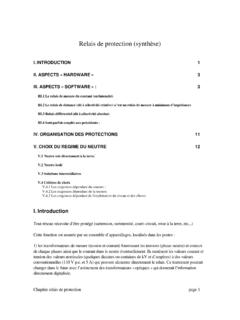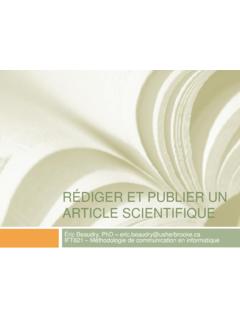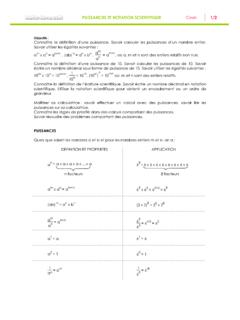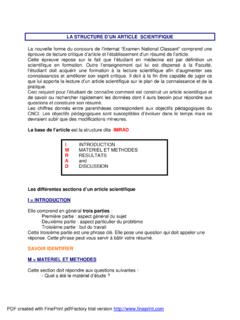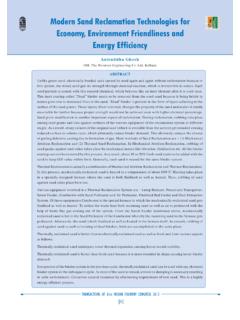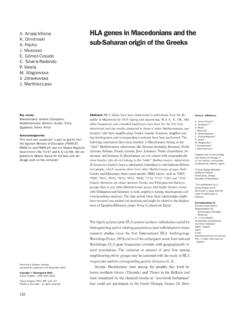Transcription of Power Line Aeolian Vibrations. - ULiege
1 Department of Electronics, Electricity and Computer Sciences Transmission & Distribution of Electrical Energy Power line Aeolian Vibrations. Prepared by: Pr. J-L Lilien November, 2013 2 Table of Contents Table des mati res 1 Introduction .. 3 2 General Approach .. 5 Conductor self damping .. 6 Wind Power input .. 9 3 Energy Balance Principle .. 11 4 Endurance limit .. 12 5 Earthwires and OPGW .. 18 OPGW clamping 18 Test Procedures - Fittings for OPGW on overhead lines .. 20 6 Analysis of Safe Design Tension .. 21 7 Stockbridge-type damper .. 22 8 Conclusions .. 24 9 References .. 25 3 1 Introduction Aeolian vibration is a low amplitude (conductor diameter) high frequency (5 to 150 Hz) phenomenon. Aeolian vibration is one of the most important problems in transmission lines because it represents the major cause of fatigue failure of conductor strands or of items associated with the support, use, and protection of the conductor.
2 In this phenomenon, conductor strand fatigue failures occur at the suspension clamps or at the clamps of the other devices installed on the conductor such as spacers, spacer dampers, dampers and other devices. Fig typical broken strand due to Aeolian vibration after removal of suspension clamp. Forces induced by vortex shedding are the cause of this type of vibration (Blevins-1990, Buckner 1968, Claren et al 1969 & 1974). The response of the conductor to vortex shedding excitation is strongly non linear in terms of the vibration amplitude. This non-linearity is related to both the conductor parameters and the characteristics of the wind blowing across the conductor. In this phenomenon, maximum vibration amplitudes can be, at maximum, about one conductor diameter (peak-to-peak) where they can cause fatigue of the conductor strands due to bending. The problem may be defined as controlling the conductor vibration amplitude in order to maintain the stress in the conductor strands below the fatigue endurance limit.
3 Adequate control can be achieved if the correct amount of damping is present in the system and if necessary, additional damping can be introduced in the form of damping devices such as dampers and spacer-dampers. The complex phenomenon of vortex shedding (fig. ), from an engineering point of view is simplified through an approach known as Energy Balance Principle (EBP): this approach does not reproduce all the phenomenon features but allows for the definition of the maximum vibration amplitudes undergone by the conductor due to Aeolian vibrations: the steady state amplitude of vibration of the conductor or bundle due to Aeolian vibration is that for which the energy dissipated by the conductor and other devices used for its support and protection, equals the energy input from the wind. 4 The energy introduced by the wind to single and bundle conductors has been determined through wind tunnel measurements.
4 Vortex shedding excitation on a vibrating cylinder, as already said, is quite a complicated phenomenon, which will cover aspects as vortex shedding frequency, lock-in, synchronization range, modes of vortex shedding, variables controlling the phenomenon and energy input for both single and bundle conductors. The energy dissipated by the conductor and damping devices can be determined through laboratory measurements From the comparison between introduced and dissipated energies, the steady state amplitude of vibration (fig and ) of the conductor can be evaluated together with strains and stresses in its most significant sections. Fig Flow visualization; identification according to (row, column): (1,1) R= (Taneda) , (1,2) R= (Taneda), (2,1) R=26 (Taneda), (2,2) R=140 (Taneda), (3,1) R=2000 (Werl & Gallon), (3,2) R=10000 (Corke & Nagib) Fig Transient response measured at the antinode of an aero elastic model of a conductor after Brika & Laneville (1993) 5 Fig record of natural Aeolian vibrations (EPRI 1979).
5 Amplitude vs time. 2 General Approach Under moderate wind speed (generally lower than 7 m/s) Von Karman vortex shedding will induce vertical vibrations at frequencies depending on the Strouhal relationship (the Strouhal number is about for all typical Power lines cables) : (eq ) Where V is the wind speed (m/s), D the conductor diameter (m) and f the vibration frequency (Hz). Thus a given diameter and a given wind speed are giving a frequency of vibration . That frequency is always close to an eigenfrequency of the span concerned as these frequencies are very close to each other, separated by the basic frequency, close to to Hz. It is generally a very high mode number (20 to 80 ) which means numerous loops in one span (fig ). The loop length is simply given by the ratio between the the wave propagation speed (= square root of the ratio tension/mass) and the frequency of vibration , generally the wave length is about some meters.
6 Fig typical wave shape during Aeolian vibration Example : twin 2x620 mm2 AMS tensioned at 35000 N/conductor on a span length of 350m. The subconductor of 620 mm2 has external diameter and a mass of kg/m. Sag can be estimated at m (ratio sag/span = ) Wave propagation speed : sqrt (35000 ) = 143 m/s Basic swing frequency : ( (sag))= Hz The Aeolian vibration frequencies are (range wind speed to 7 m/s) : 3 Hz to 40 Hz Wave length of these frequencies : 48 m (3 Hz) to m (40 Hz). 6 The Energy Balance Principle (EBP) (wind Power in = self dissipation + damper out) is used for analysis of the system, it helps to define amplitudes of vibrations at each frequencies. Next steps are evaluating maximum bending strains in the conductor to evaluate its protection against Aeolian vibration and to highlight, if any, dangerous frequency ranges. Dangerous range are linked to fatigue limit of the corresponding cable+fixation system.
7 One hour vibrations at 20 Hz every day would means 26 Megacycles per year. To apply EBP numerous investigations have been done to determine basic inputs to be used. Conductor self damping A stranded conductor will consume energy when it is bended, mainly due to friction between the strands as they moved relatively to each other. The dissipation energy increases with increasing frequency, amplitude and conductor diameter. (Electra-1979) Conductor self-dissipation, it is a function of static tensile stress in the Aluminium layers. The higher the tensile stress, the tighter the layers will lock, and the less inter-strand friction, which is the main source of self-dissipation, will take place when the conductor is curved during vibration . Conductor self dissipation may be calculated by the empirical rules (Electra 1988): nmlCTfAkP= [W/m] (eq ) where: Pc = Power per unit length dissipated in the conductor [W/m] k = factor of proportionality [see below for unit] A = Maximum Amplitude (pk-pk) [m] f = frequency [Hz] T = Conductor tension [kN] The conductor k factor is a special function involving the diameter, rated strength, and mass per unit length of a conductor [EPRI 1979].
8 MRSdk = (eq ) Where d is a conductor diameter [mm], RS is rated strength [kN], m is mass per unit length [kg/m]. 7 Quantities l, m and n are amplitude exponent, frequency exponent and tension exponent respectively. These exponents are investigated by many investigators varies a quite a bit (see table , Electra 1988). It is to be noted that moderate differences in the exponent values lead to huge differences in the self-damping values. Table : Exponent values for self-dissipation For example, Noiseux s exponents may be used as follows to calculate the self-dissipation Power (Pc) of conductor : [W/m] (eq ) For reduced self-dissipation the formula shall be; =dAfTdkdfPC [W. s3/m5] (eq ) There exist IEEE recommendations to perform appropriate testsing to evaluate Pc with a good level of precision on a test bench (IEEE- 1993 and Electra-1979). Visualisation of reduced self dissipation is shown on fig and with different scaling.
9 8 Fig Reduced Power dissipation, an example (log scale) Figure Results of Power dissipation (Bear conductor at 20% UTS) (linear scales). The two extra curves are the wind Power input (see later). It must be noted that there are big discrepancies between actual value and formula as detailed in (Electra 1988) and shown on fig Figure : Data scattering of Conductor self dissipation. Dots are covering all ranges of frequencies and amplitudes. 9 More recently, a better model has been developed based on a needed test lab on a conductor sample. That test is purely a static test and is evaluating a hysteresis curve representative of the inter-strand friction. More is detailed in the exercise proposed to the student. Wind Power input The mechanical Power transferred from the wind to a vibrating conductor may be expressed in the general form: 34 WAPLf D FD = (eq ) Where PW = mechanical Power imparted by the wind to the whole span of a conductor (W) A = vibration amplitude (m) L = span length (m) f = frequency of vibration in (Hz) D = diameter of conductor in (m) AFD = a function of the vibration amplitude AFD is a nonlinear function of the dimensionless vibration amplitude.
10 Several laboratories have tried to express the AFD . Their results however differ a lot even shown in logarithmic scale. This is because the measurements of these small energy levels (fractions of a watt per meter of conductor) are very sensitive to disturbances. AFD is given in [Rawlins- 1998] for different turbulence levels (1, 5, 10, 15, 20%) An example of wind Power curves for different turbulence levels is given in fig. Alcoa Laboratories has made a study in terms of parameter, related to a wind Power input, which is a function of reduced velocity Vr, dimensionless amplitude [Y/d], and reduced decrement r .The reduced decrement can be converted in reduced wind Power , 43dfPW, through this relationship. 2max2434 =dYdfPrW [ ] (eq ) Where = mass density of the fluid medium; kg/m3 =r reduced decrement The value of reduced decrement,r , for different amplitude and for different level of turbulence studied by Alcoa Laboratories are given table below (Rawlins- 1998) 10 The reduced wind Power ,43dfPw, which is a function of relative amplitude, has been drawn for different level of turbulence, see figure Increasing the turbulence level decreases the wind Power input.
